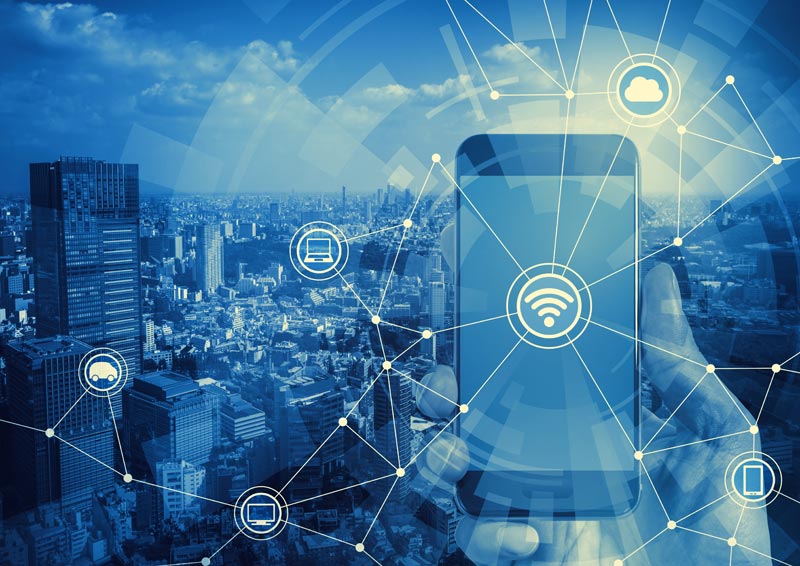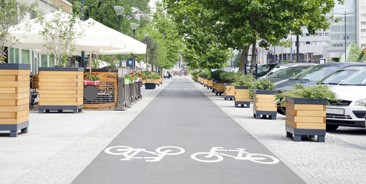A co-editor of Energy and Mobility in Smart Cities, William J Nuttall, on how Covid-19 sped up the development of smart cities.

- Updated: 01 Apr 2021
- Author: Professor William J Nuttall, The Open University, UK
The vulnerabilities of cities
Professor Brene Brown, University of Houston, USA, has memorably said: “Vulnerability is the birthplace of innovation, creativity and change.”
In the early twenty-first century, the concept of the smart city has been closely linked to one global vulnerability above all others – climate change. It prompts a need to drastically reduce harmful greenhouse gas emissions. The smartness provided by digital communications can help to reduce the negative climate impact of transport, heating, manufacturing and the provision of public services. Smart cities are built on affordable and highly portable computing technology with always-on internet connectivity. This allows us to do business and socialise in ways that, not long ago, would have been unimaginable, while also helping to mitigate climate risks.
The smart city has long been a goal motivated by both hopes and fears. Another issue sitting behind the emergence of the smart city has been security. There has been the hope that greater IT enabled vigilance might protect society from the threat of terrorist violence and organised crime. The flip side to such hopes however, has been the fear that individuality and free expression will be suppressed by a pervasive surveillance society and a new zeitgeist of social conformity. There is also a fear that the new IT capabilities will expose society to emergent cyber risks from criminal hackers and even cyber warfare teams sponsored by hostile nations.
The greatest crisis-based impetus to the smart city, however, has come from the Covid-19 global public health emergency – the enduring consequences which are likely to be profound. In the first weeks of the pandemic the UK saw a massive swing away from traditional retailing towards online shopping. It was one of many ways in which a decade’s worth of innovation and social change was forced in just a few weeks.
‘Lockdowns’ have occurred in the past
The links between the smart city and lockdown run both ways. Lockdown has boosted smart city innovation and has accelerated change. One can also argue that smart cities provided much of the IT capability needed for life in lockdown (e.g. shopping, health care access, public services etc). Such lockdown measures would simply not have been possible in the 1980s or 1990s. Technology made lockdown feasible and plausibly affordable.
It was not the Covid-19 crisis that provided the first example of such a technology-mediated lockdown. For example, in April 2013, the smart city of Boston in Massachusetts, USA, was hit by terrorist bombings at the end of its annual marathon. Following the blasts, the terrorists went on the run and the suburban community of Watertown was placed into lockdown. The whole of the city of Boston was told to ‘shelter in place’. This was not a legally enforceable order, nevertheless, it was widely-respected and the huge city was deserted. As we now know, it would be a forerunner of things to come for cities everywhere.
Traditional cities innovate and change
Historic European capital cities, such as Paris, France and London, UK are smart cities – the recent Covid-19 crisis confirms this. The pandemic crisis hit these cities very hard, but their capacity to change and innovate was exceptional, both technically and socially. For example, many people have shifted to internet-enabled working from home; the concomitant shift away from urban commuting is dramatically visible in official transport statistics. One can also see a major shift in the UK towards cycling (especially for leisure and exercise purposes at weekends). The crisis has redefined the workings of the city from working, commuting, through shopping and leisure activities. Some of these new habits will surely endure.
New urban spaces emerge
The early decades of this century have seen new pressures shaping our cities’ streets. The terrorist fears of the years after 9/11 saw the emergence new security bollards and countermeasures for urban security. The looming threat of climate change and concerns for urban congestion have seen ever strengthening IT-enabled measures aimed at restricting the use of polluting vehicles in city centres. The Covid-19 crisis has accelerated the downturn in city-centre retailing. The hospitality sector has also been hit hard, but it can be expected to bounce back strongly on the pent-up demand for social interaction. It is said that the future urban experience will be a social experience as never before.

A lot more space is now dedicated for active travel
The pressures on urban living prompted by climate change action are far from contained. In mobility we can expect a shift towards shared vehicle use and away from private family car ownership, accompanied by a shift to electric vehicle use. These trends should mean fewer, but much more intensively used, cars in our cities. There will be less need for street parking and there will be a need to design charging infrastructures for city apartment dwellers.
Consequently, urban streets could soon look very different. It is already the case that services like Uber and Zipcar are made possible by app-based technologies and many people already find it easier to book a car than to remember, as they used to have to do, where they had parked their own car the night before.
Our cities will have fewer vehicles, but those vehicles will be moving more. We already see this with the ubiquitous delivery vans rushing around with our online purchases. Eventually driverless autonomy will come, further altering the feel of our cities and the balance of employment within them.
Good governance matters
The crises that have boosted smart city innovation and entrepreneurship have also caused much hardship. These negative consequences fall disproportionately on the poor. The Financial Times’ Valetina Romei has produced an excellent video that expands upon such ideas.
Our recent book Energy and Mobility in Smart Cities, available as a print book and an eBook, gives specific emphasis to issues of governance in the smart city including: legitimacy of action and citizen involvement. The book stresses the importance of data to guide understanding and the need for evaluation of exemplary smart cities. Simulation and modelling also has an important role to play in assessing change in such complex systems.
Contemporaneous with the Covid-19 crisis, we have seen a growing concern about the role of the police and community trust in the state. If the smart cities of the future do not adopt appropriate governance, there is a risk that authoritarian power and crisis-appropriate norms will persist long after Covid-19 has passed. In the book the authors of chapter 11 rightly point to some words from William Shakespeare that we should all remember:
Sicinius: What is the city but the people?
Citizens: True, the people are the city
William Shakespeare, Coriolanus, Act 3, Scene 1.
